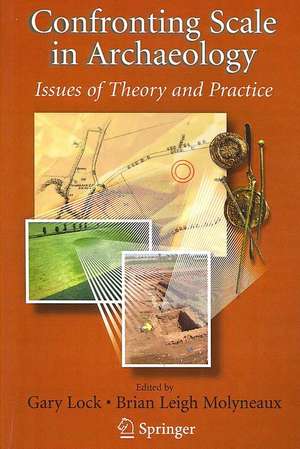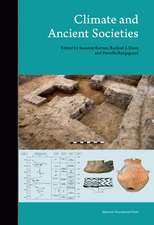Confronting Scale in Archaeology: Issues of Theory and Practice
Editat de Gary Lock, Brian Molyneauxen Limba Engleză Paperback – 15 noi 2007
| Toate formatele și edițiile | Preț | Express |
|---|---|---|
| Paperback (1) | 386.81 lei 6-8 săpt. | |
| Springer Us – 15 noi 2007 | 386.81 lei 6-8 săpt. | |
| Hardback (1) | 643.16 lei 6-8 săpt. | |
| Springer Us – 31 aug 2006 | 643.16 lei 6-8 săpt. |
Preț: 386.81 lei
Nou
Puncte Express: 580
Preț estimativ în valută:
74.02€ • 76.48$ • 61.57£
74.02€ • 76.48$ • 61.57£
Carte tipărită la comandă
Livrare economică 20 martie-03 aprilie
Preluare comenzi: 021 569.72.76
Specificații
ISBN-13: 9780387757018
ISBN-10: 0387757015
Pagini: 280
Ilustrații: XIV, 280 p.
Dimensiuni: 155 x 235 x 15 mm
Greutate: 0.39 kg
Ediția:2006
Editura: Springer Us
Colecția Springer
Locul publicării:New York, NY, United States
ISBN-10: 0387757015
Pagini: 280
Ilustrații: XIV, 280 p.
Dimensiuni: 155 x 235 x 15 mm
Greutate: 0.39 kg
Ediția:2006
Editura: Springer Us
Colecția Springer
Locul publicării:New York, NY, United States
Public țintă
Professional/practitionerCuprins
Introduction: Confronting Scale.- Introduction: Confronting Scale.- Introducing Scale: Space, Time and Size in The Past and the Present.- On Being the Right Size: Affordances and the Meaning of Scale.- Timescales.- Scale as Artifact: GIS, Ecological Fallacy, and Archaeological Analysis.- Artifacts as Social Interference: The Politics of Spatial Scale.- Constructing Scale: Identifying Problems.- Topographical Scale as Ideological and Practical Affordance: The Case of Devils Tower.- Perspective Matters: Traversing Scale through Archaeological Practice.- Artifacts as Landscapes: A Use-Wear Case Study of Upper Paleolithic Assemblages at the Solutré Kill Site, France.- Scale and Archaeological Evaluations: What are We Looking For?.- Scale, Model Complexity, and Understanding: Simulation of Settlement Processes in the Glenwood Locality of Southwestern Iowa, 1976 and 2000.- Scale and Its Effects on Understanding Regional Behavioural Systems: An Australian Case Study.- Custer’s Last Battle: Struggling with Scale.- Interpreting Scale: Towards New Methodologies and Understandings.- Temporal Scales and Archaeological Landscapes from the Eastern Desert of Australia and Intermontane North America.- Large Scale, Long Duration and Broad Perceptions: Scale Issues in Historic Landscape Characterisation.- Multiscalar Approaches to Settlement Pattern Analysis.- Grain, Extent, and Intensity: The Components of Scale in Archaeological Survey.- Persons and Landscapes: Shifting Scales of Landscape Archaeology.
Recenzii
"Archaeologists from North America, Europe, and Australia grapple with the concept of scale and its intentional and unintentioanl influence in their practice. The fundamental problem is that archaeologists, being human, have trouble imagining things very much larger or very much smaller than humans, and things very much longer or very much shorter than a human lifetime. The contributions look at space, time, and size in the past and the present; problems of scale and their identification; and new methodologies and understandings for interpreting scale." (Reference and Research Book News, November 2006)
Textul de pe ultima copertă
Without realizing, most archaeologists shift within a scale of interpretation of material culture. Material data is interpreted from the scale of an individual in a specific place and time and then shifts to the complex dynamics of cultural groups extending over time and space. This ignoring of scale is the "concession" archaeologists make to interpretation. The introduction of geographical information systems (GIS) remote sensing, and virtual reality have expanded the scale at which data is interpreted even more, using multiple scales at the same time without recognizing the significance of their actions.
This book discusses the cultural, social and spatial aspects of scale and its impact on archaeology in practical and applicable cases. Each author takes one of the fundamental elements of archaeology - from the experience of time and space to the visualization of individuals, sites and landscapes to the intricacies of archaeological discourse - and shows how an awareness of scale can create new and exciting interpretations.
This book discusses the cultural, social and spatial aspects of scale and its impact on archaeology in practical and applicable cases. Each author takes one of the fundamental elements of archaeology - from the experience of time and space to the visualization of individuals, sites and landscapes to the intricacies of archaeological discourse - and shows how an awareness of scale can create new and exciting interpretations.
Caracteristici
Discusses the cultural, social and spatial aspects of scale and its impact on archaeology in practical and applicable cases Includes supplementary material: sn.pub/extras












